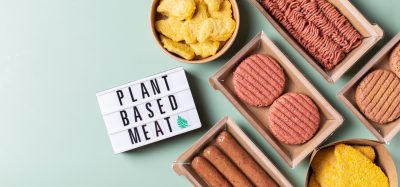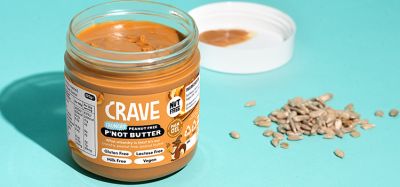Ingredients: Lowering the fat content in cheese
- Like
- Digg
- Del
- Tumblr
- VKontakte
- Buffer
- Love This
- Odnoklassniki
- Meneame
- Blogger
- Amazon
- Yahoo Mail
- Gmail
- AOL
- Newsvine
- HackerNews
- Evernote
- MySpace
- Mail.ru
- Viadeo
- Line
- Comments
- Yummly
- SMS
- Viber
- Telegram
- Subscribe
- Skype
- Facebook Messenger
- Kakao
- LiveJournal
- Yammer
- Edgar
- Fintel
- Mix
- Instapaper
- Copy Link
Posted: 2 September 2014 | Dr E. Allen Foegeding, William Neal Reynolds Distinguished Professor, North Carolina State University | No comments yet
The world food supply is constantly transforming to meet consumer needs that vary from culture to culture. Lowering the fat content in certain foods has been a goal for several decades due to either a desire to reduce overall calories or avoiding certain types of fat, or fat in general. Cheese is a logical target for fat reduction as it reduces caloric density of a food that is a good source of protein and other nutrients. A cursory review of the literature found that production of a ‘low-fat soft-ripened cheese’ was investigated as early as 1954
Reducing fat content while maintaining desirable sensory properties is extremely difficult because fat contributes a range of attributes to a food that are hard to match with one, or several, ingredients and processing alterations. The basic postulation for making a food product is that molecules are processed into structures that are associated with specific properties of the food product. This builds on the process – structure – properties concept proposed by Erich Windhab2. A generalised process for rennet set cheeses is outlined in Figure 1.
Cheese can be viewed as a composite material. There are two composite material models that can be used to describe the cheese making process and cheese structure. The first is a ‘filled gel’ or more specifically, an ‘emulsion-filled protein gel’3. In the first process (Figure 1; Process 1, page 52), rennet is added to whole milk and a casein gel is formed around dispersed milk fat globules. The milk fat globules are the dispersed phase of an emulsion that becomes trapped in the rennetinduced casein network. The gel network is conceptualised as strands of casein micelles that are cross-linked into a three-dimensional structure. The interactions connecting the strands are such that when the gel is placed in a solvent the structure will swell or shrink, at least on the time scales associated with eating.
The second model is a ‘jammed system’ of protein gel and fat particles. The starting system is particles, with varying degrees of inter-particle attraction, suspended in a fluid. When the particle volume fraction increases, by draining whey, the particles reach a critical volume fraction and the fluid is transformed into a solid4. This occurs in the second and third processes (Figure 1; Process 2 and 3) where conditions are designed to remove whey from the curds and pack the curds into the initial cheese structure. The cheese structure initially formed will show distinct boundaries between curds (so called curd junctions). If inter-particle interactions are weak, then addition of a fluid phase should dilute the system and it will become an ‘un-jammed’ liquid. Therefore, it is possible that during the time scale of eating you have some un-jamming of particles and a rapid solid-to-fluid transition. It is logical that Process 1 produces an emulsion filled protein gel, followed by Process 2 creating a jammed system, but the precise physical state of the final cheese will vary with age and among types of cheese. One can argue in cheeses such as Cheddar, when curd junctions disappear upon aging, the gel particles become a continuous gel phase and the cheese is an emulsion-filled gel. However, one cannot rule out that at some scale there is jamming of particles. This will be addressed again when sensory properties are discussed.
Emulsion-filled protein gel model applied to Cheddar cheese
Rheological properties of emulsion filled gels are predicted based on properties and volumes of the gel and particle phases, and if there are interactions between the particle and gel phases3. The shear modulus (G) of a filled gel can be modeled based on the volume fraction of the filler particle (f) and the G of each phase. Shear modulus is shear stress/shear strain measured under conditions that do not damage the gel network. This can be viewed as the ‘rigidity or stiffness’ of a gel, and should be distinguished from sensory texture terms such as hardness and firmness that are used interchangeable to describe the force required to rupture a food. An equation that has been applied to emulsion-filled protein gels is that of van der Poel (1958)5 in the form of the simplified version of Smith (1975)6:
This predicts that the shear modulus (100 per cent elastic) of the material (cheese in our case) relative to the shear modulus of the gel matrix (Gm) will depend on the following:
vm = Poisson ratio of the matrix
M = Gf /Gm; shear modulus of fat particle (Gf) and gel matrix
Q = (8 – 10vm)M + 7 – 5vm
f = Volume fraction of particle.
This implies that adjusting the amount and properties of the gel matrix and/or the filler phase can make a low-fat cheese with the same G as the full-fat version. While filled-gel models provide a good framework for structure formation, there are a number of factors that must be considered. One is that the model assumes elastic deformation when cheeses are viscoelastic. However, using the storage modulus (G¢) or complex modulus (G*), and not accounting for viscous effects, works reasonably well with emulsion-filled protein gels3. Another concern is that the rheological properties of fat change dramatically with the percentage of solid fat. Cheddar cheese with a G¢ value of ~600 kPa at 10°C has a G¢ value of ~150 kPa at 25°C7. Moreover, between 20 and 25°C, G¢f = G¢m and the filler volume does not affect the G¢ of the cheese. If G¢ is the critical property, then filler volume has no effect in this temperature range. Probably the biggest limitation is that G¢, while clearly related to filled gel structure, is a poor predictor of sensory texture. This is because texture assessment involves fracturing the cheese into particles and mixing with saliva to form a bolus.
Properties of cheese
Desirable cheese properties can be separated into those measured by physical and/or chemical means, and those initially formulated based on biological assessment. Slicing, shredding, and melting of cheese can all be defined based on physical properties. In contrast, sensory texture, specific flavours, and flavour release are concepts initially established by human assessment. These properties may be understood to a degree that they can be assessed by physical/chemical means, or the underlying complexity may dictate human assessment as the best overall measure. A reduction in the fat content of cheese can alter melting, slicing, shredding, flavour and texture, but the focus here will just be on texture.
A recent tactic has been to approach sensory texture based on the oral processing events that are required to form a bolus8. Sensory texture terms can be separated into two groups. First are terms assessed at force – deformation levels from minimal all the way up to levels causing fracture (Figure 2). Force, deformation, and fracture can be assessed by either mechanical tests or by humans with their fingers or teeth. Examples of sensory terms in this category are hardness, firmness, springiness, and deformability; with precise definitions varying among investigations8. These terms are associated with one bite (incisors) or chew (molars) in oral processing. The second group of terms involves breaking down the food into particles, mixing with saliva, and forming a bolus during mastication. (Figure 2). Terms such as cohesiveness, adhesiveness, and smoothness of mass fit in this category.
An early investigation on fat reduction in cheese showed that Cheddar cheese containing 17.5 per cent fat was firmer and more elastic that full-fat (35.5 per cent fat) cheese9. The reduced-fat cheese was also less cohesive and smooth. This trend was also seen in commercial full- and reduced-fat cheeses evaluated 22 years later10. Cheese is consumed as slices or cubes and it is possible that sensory texture will vary with sample size. Commercial samples of low, reduced, and full-fat Cheddar cheese were used to determine the differences in texture associated with sample size11. All samples had a 20mm by 20mm surface but the thickness varied from 2mm (slice) to 20mm (cube). The slice was judged less firm at each fat level (Table 1). This is logical since firmness was assessed as “the amount of force required to completely compress the sample between thumb and first two fingers (hand firmness) or bite through sample using molars (first chew firmness)11”. Larger samples should require more force. However, this does not remove the effect of fat level that is seen with both sample sizes and shows that reduced and low-fat cheeses are firmer than full-fat cheese. In comparison, sample size has little to no influence on cohesiveness, adhesiveness, and smoothness of mass (Table 1). These terms are all assessed after five chews and reflect structural breakdown of the cheese, mixing with saliva, and re-combining into a bolus.
Approaches for fat reduction
The simplest approach is to reduce the fat phase and keep the properties of the gel phase constant. This would imply that Gm does not change. It would predict that the overall stiffness of the cheese would increase, decrease, or remain the same depending on ‘M’ (see van der Pole equation). The ideal approach would be to add a filler with Gf values that are similar to fat in absolute values and changes with temperature. This would at least set-up a similar structure as defined by van der Poel theory. Note that the first chew firmness values of low-fat cheese are 1.6 times as firm on first bite as full-fat cheese (Table 1). Much work has been done on what determines fracture and firmness in cheese, and it is plausible that adjustments can be made to the gel matrix to reduce the firmness. Unfortunately, a purely fracture mechanics approach focusing exclusively on first bite terms will not produce a cheese of similar texture – you still need to match the terms evaluated after several chews. Cohesiveness, adhesiveness, and smoothness of mass combined have values for full-fat cheese that are 2.2 times those of low-fat cheese (Table 1). These terms all involve evaluation of spatial, surface, and mechanical properties (Figure 2). Therefore, the ideal low-fat cheese not only has to initially fracture the same as full-fat cheese but must follow a similar pattern of transformations during oral processing that involves continuous particle reduction and mixing with saliva to form a bolus (Figure 2).
The models of an emulsion-filled gel or jammed particles can be used to speculate on what might be happening during oral processing. Multiple fractures produce a range of particle sizes, this causes fat to be exposed on the surface of particle or released. As particles are generated (and possibly fat released), they are mixed with saliva, which can function in diluting components and adhering the particles into a cohesive mass. The precise contribution of physical/chemical properties of fat in sensory cohesiveness, adhesiveness, and smoothness of mass remain unclear. An investigation on oil release from emulsion-filled gels concluded that “…the release of oil droplets during oral processing is not the main mechanism causing creaminess perception on emulsion filled gels12”. We still have much to learn.
There are some key questions that remain to be answered. The first being, is there a requirement for at least some minimal level of fat to produce desired textural properties? The second concerns the role of the gel matrix in cohesiveness, adhesiveness, and smoothness of mass. These terms all increase with aging of full and low-fat cheese, but the low-fat cheese never reaches the same level13. Finally, what is the precise function of the filler phase? This is fairly well understood for first bite texture terms but remains elusive for those determined after mastication (Figure 2).
Conclusion
Producing low-fat versions of cheeses that normally have significant levels of fat (above 20 per cent fat is a good estimate) requires breakthroughs in our understanding of how fat contributes to food structure transformations and associated sensory perception during oral processing. One line of research is to determine how a cheese structure should fall apart and re-form into a bolus during oral processing to produce the desired textural properties. Once that is understood, the challenge will be developing formulations and processes that build the desired structural elements.
References
- Reisfeld, R.A., Harper, W.J. (1954), A low-fat soft-ripened cheese, Journal of Dairy Science, 37, 639.
- Windhab, E. http://archivos.labcontrol.cl/wcce8/offline/techsched/manuscripts/xt5i4b.pdf
- Dickinson, E. (2012), Emulsion gels: the structuring of soft solids with protein-stabilized oil droplets, Food Hydrocolloids, 28, 224-241.
- Trappe, V., Prasad, V., Cipelletti, L., Segre, P.N., Weitz, D.A. (2001), Jamming phase diagram for attractive particles, Nature, 411, 772-775.
- Van der Poel, C. (1958), On the rheology of concentrated dispersions. Rheologica Acta, 1, 198-205.
- Smith, J.C. (1975), Simplification of van der Poel’s formula for the shear modulus of a particulate composite. Journal of Research of the National Bureau of Standards, 79A, 419-423.
- Yang, X., Rogers, N. R., Berry, T. K., Foegeding, E.A. (2011), Modeling the rheological properties of cheddar cheese with different fat contents at various temperatures, Journal of Texture Studies, 42, 331-348.
- Pascua , Koç, H., Foegeding. E.A. (2013), Food structure: roles of mechanical properties and oral processing in determining sensory texture of soft materials, Current Opinion in Colloid and Interface Science,18, 324–333.
- Emmons, D.B., Kalab, M., Larmond, E., Lowrie, R.J. (1980), Milk gel structure. X. Texture and microstructure in Cheddar cheese made from whole milk and from homogenized low-fat milk, Journal of Texture Studies, 11, 15-34.
- Gwartney, E.A., Foegeding, E.A., Larick, D.K. (2002), The texture of commercial full-fat and reduced-fat cheese, Journal of Food Science, 67, 812-816.
- Barden, L.M., Drake, M.A., Foegeding, E.A. (2012), Impact of sample thickness on descriptive analysis of Cheddar cheese, Journal of Sensory Studies, 27, 286-293.
- Sala, G., van de Velde, F., Cohen Stuart, M.A., van Aken, G.A. (2007), Oil droplet release from emulsion-filled gels in relation to sensory perception, Food Hydrocolloids, 21, 977-985.
- Rogers, N.R., Drake, M.A., Daubert, C.R., McMahon, D.J., Bletsch, T.K., Foegeding, E.A. (2009), The effect of aging on low-fat, reduced-fat and full-fat Cheddar cheese texture, Journal of Dairy Science, 92, 4756-4772.
About the author
Dr. E. Allen Foegeding is a William Neal Reynolds Distinguished Professor at North Carolina State University. Dr. Foegeding conducts research and teaches in the areas of food structure, protein functionality, and polymer and colloidal properties of food products, with emphasis on whey proteins and dairy products.







